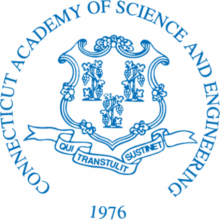Imagine fluids flowing up the side of a container, rather than down. Now imagine levitated vehicles transporting us as if we were suspended in space. And finally, can you imagine super powerful computers that rely on qubits (quantum mechanical bits) to process information, enabling these computers to decode complex encryptions that otherwise are considered indecipherable? These are only a few of the many possibilities created by work being done in the field of quantum mechanical matter, a field of study that is of particular interest to Dr. William Stwalley, Chair of the Physics Department at the University of Connecticut and recipient of the 2005 Connecticut Medal of Science Award as well as the William F. Meggers Award of the Optical Society of America for outstanding work in spectroscopy, and the Chancellor’s Research Excellence Award at the University of Connecticut (UConn). He has been a member of the Connecticut Academy of Science and Engineering since 1994.
Dr. Stwalley was born in Glendale, California, but because of his father’s work as a quality control expert with Douglas Aircraft, his family moved many times in the southern California area. He fondly recalls those early years in Santa Monica, when he lived only eleven blocks from the beach and in the summertime, on his way home from the beach, he frequented a comic shop where he bought used comics for only a penny. He still has his comic book collection, including Donald Duck and Uncle Scrooge, and at least one rare comic, valued today at somewhat more than a penny.
While a student at Fullerton High School, the young Bill Stwalley found encouragement for his interest in mathematics from an “outstanding teacher, Mr. Redfern.” Mr. Redfern took Bill and his fellow students to regional and statewide math competitions where Bill not only won a slide rule and a scientific encyclopedia that he still has today, but he “got to see lots of other students and see how well we performed relative to others in California.” Later, he completed his undergraduate education at Cal Tech, where he majored in physical chemistry and began the study of diatomic molecules that he believes are “simple to understand and understand well.” After receiving his PhD from Harvard University, Dr. Stwalley continued research on these molecules and studied the very unique ways in which atoms and molecules react under extremely cold conditions, below 1°K (Kelvin). Unlike ordinary molecules, ultracold diatomic molecules do not collide like “billiard balls” and in some cases “go through each other.” Although this area currently involves basic research, there exist many possible applications of quantum mechanical matter. Dr. Stwalley expects many significant examples to evolve in the next few decades.
Dr. Stwalley finds UConn to be a very exciting environment because of the work being done on ultracold science and the contribution he is able to make by educating graduate students and “teaching them how to think well and develop their own ideas.” He believes that “young people need to know how to ask questions and know what they don’t know.” Dr. Stwalley has enjoyed observing his three granddaughters and their love for science, although he is concerned with the challenge of “stimulating scientific interest in young children and then maintaining that interest as children mature, particularly in light of competition from many forms of entertainment.” Dr. Stwalley would most like to be remembered as a good person, a good scientist and a good teacher who has contributed many exciting ideas over the years.


